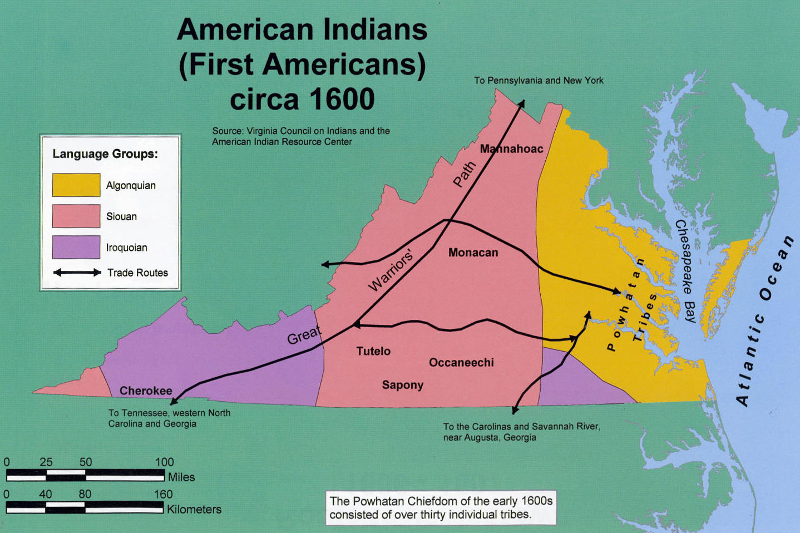
areas dominated by different language groups in 1600
Source: Virginia Geographic Alliance, An Atlas of Virginia (Map 26)
The English were well aware that Virginia was already occupied by humans when the colonists first arrived in 1607. Since the early 1500's, ships with captains from various nations had interacted with Native Americans in the Chesapeake Bay area.
Virginia was not "unoccupied" or "empty," and John Smith's map identified numerous towns on the shorelines of the Virginia rivers. The English understood that the Native Americans had their own government in Virginia. Powhatan defined his capital to be at Werowocomoco, though the English re-named the river the natives called Pamaunke after the Duke of York. Many of the place names of Virginia are based on the place names used by the Algonquian-speaking tribes, such as Chesapeake, Occoquan, and Accomack. Many Algonquian names have been applied to places west of the Fall Line, such as the Roanoke River and Powhatan County. Some of the more-appropriate place names remain, however, including Manakin in Goochland County just upstream from Richmond.
By right of prior settlement, Native Americans could claim ownership of Virginia. However, there are other criteria for determining ownership. As English colonists arrived and the population of "tassantassas" (foreigners) grew, Native Americans were unable to maintain control over the land through either military or legal processes.
At times, the English just finessed the native land claims, ignoring them while granting patents (legal deeds for ownership) to portions of Virginia to European settlers. The English justified such actions because the lands were unoccupied, and perhaps because the tribes were not "civilized" or Christian. At other times, when the English wanted to avoid military conflict with the tribes, the land claims of the Native Americans by right of prior settlement were also considered in Virginia.

areas dominated by different language groups in 1600
Source: Virginia Geographic Alliance, An Atlas of Virginia (Map 26)
Measuring actions in the past by standards of the present, an anachronistic approach described as "presentism," can create misleading impressions of morality and legality. The occupation of Virginia by European colonists in the 1600's was legal, based on English law at that time. Of course, if English colonization in the 1600's was measured by the Native American equivalent of English common law, a different conclusion could be reached.
The morality of the behavior of English colonists in the 1600's is a different question than the legality of occupation. One way to assess English behavior in Virginia is to compare it to Spanish, Dutch, and French interactions in their North American colonial settlements.
Another reference point is to compare English behavior to the interactions between various Native American tribes. Virginia was not a land of peace and harmony before Europeans disrupted Native American society. The hard-to-build palisades that surrounded most Native American towns in Virginia, when English colonists arrived, demonstrate that conflict over territorial control was common between tribal groups.
Powhatan controlled over 30 tribes living within his territory (Tsenacommacah), but his authority over Algonquian-speaking tribes north of the Rappahannock River was limited. Monacan/Manahoac in the Piedmont, and Iroquoian-speaking tribes living in the Nottoway and Meherrin watersheds, clearly had leaders other than Powhatan.
In addition, a comparison of colonists' actions vs. the moral teachings of that era may illuminate how land acquisition in Virginia was consistent/inconsistent with the moral guidance from English religious leaders of that time. Even today, kings and queens of England are still the supreme head of the Church of England. During Virginia's colonial period, the head of state could make final judgments on both civil and moral issues.
When Virginia was settled, international law was even looser than it is today... which is still very loose. More than 60 years after the founding of the United Nations, enforcement of most legal constraints are limited to the boundaries of a single nation. Within many nations, the power of the national government is limited through either custom or overt political resistance. For example, in the late 1950's the state government of Virginia pursued "massive resistance" to an order of the US Supreme Court to desegregate schools.
Economic sanctions - and occasionally military power - still substitute for peaceful enforcement of international decisions when one country refuses to comply voluntarily with a decision by an international body such as the World Trade Organization, World Court, Security Council/General Assembly of the United Nations, etc.
Even in the 1600's, however, the nation states of Europe had established procedures for minimizing armed conflicts while permitting economic plunder of the New World. At sea, during declared wars rulers would issue "letters of marque" authorizing private ships to seize commercial ships from another country. Once peace was declared, however, such seizures were treated as piracy... until the next war.
European countries traditionally established their legal rights to seize control of land in North America by the Doctrine of Discovery or by Right of Conquest. Popes in the Vatican issued three papal "bulls" in 1452 (Dum Diversas), 1455 (Romanus Pontifex), and 1493 (Inter Caetera). Those proclamations from the head of the Christian Church established the moral and legal basis for European land claims.
In the 1823 US Supreme Court decision Johnson v. McIntosh, Chief Justice Marshall established the American legal tradition that Native Americans had only the right to occupy land. Based on the Doctrine of Discovery, European nations had the absolute right to control the land which Native Americans might be occupying - temporarily. (In 2023, Pope Francis formally repudiated the Doctrine of Discovery.)
To establish legal ownership of colonies in North America, according to European law, actual occupation of new territory was essential in addition to discovery or conquest. Paper claims to territory, not supported by occupation, were not honored by European competitors.
That was one reason Virginians were quick to sail north and destroy a French colony in 1613 at St. Sauveur on Mount Desert Island, in what is now Acadia National Park. Eliminating the French settlement minimized the potential of a successful French claim to occupy lands also claimed by England, but still unoccupied by either nation along the Atlantic Coast. Conflict between the French and English settlers on the Atlantic coastline continued for 150 years, until the English finally expelled the French from all but two tiny islands.1
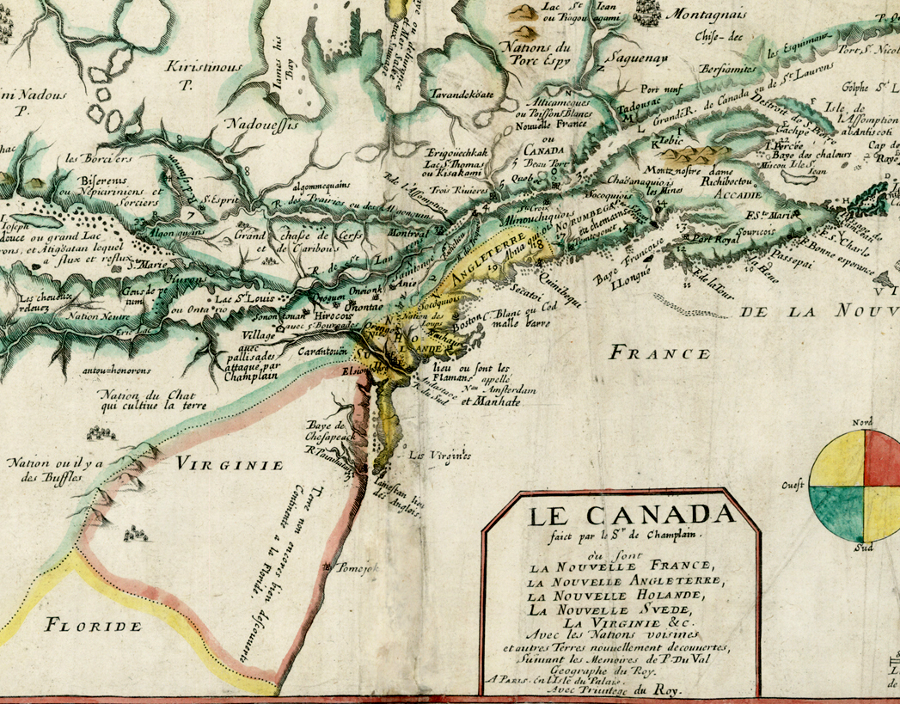
French, English, Swede, and Dutch colonies on the Atlantic coastline each occupied lands originally controlled by Native Americans,
but the major conflicts ended up being between the English vs. French and Native American forces
Source: Le Canada faict par le Sr. de Champlain. ou sont La Nouvelle France, La Nouvelle Angleterre, La Nouvelle Holande, La Nouvelle Suede, La Virginie &c...
The English approach to acquiring Native American land and establishing English law to deal with new colonial situations was different from the Spanish and French approaches. The European nations used gifts/bribery as a vehicle to obtain Native American permission to occupy various areas.
At the same time, some tribes were quite willing to sell specious claims to lands traditionally occupied by rival groups. Three separate groups sold Kentucky to the colonists. The 1768 Treaty of Fort Stanwix extinguished the Iroquois claim, the 1774 Treaty of Camp Charlotte extinguished Shawnee and Mingo claims, and the 1775 Treaty of Sycamore Shoals extinguished claims of some of the Cherokee - though Dragging Canoe pointed out that the land would be "dark and difficult to settle" because force would still be required to ensure recognition of the treaties. Of the three treaties, the Iroquois got the best deal, because they had never controlled the Kentucky territory.2
As described in one scholarly book review of colonial law:3
Some native claims in Virginia were extinguished through negotiation, and several treaties were signed by Virginia governors. The Powhatan tribes were, in the end, overwhelmed not by law, but by depopulation through disease/warfare. Waves of English immigrants filled the land once hunted/fished/farmed by the Native Americans.
Source: Fairfax Public Schools, Losing the Land
There was Native American resistance. After Powhatan died, Opechancanough led two military assaults on the English settlements in 1622 and 1644. Opechancanough recognized that the English were not just short-term occupants of a small slice of the Powhatan territory, but would physically displace the tribes and dramatically alter their culture.
The Powhatan fight to preserve their "way of life" failed, and the capacity of one leader to operate as a "paramount chief" was destroyed after the 1644 attack. The English burned all the Native American cornfields they could find, and the reduction of food forced the Powhatan tribes into submission.
The English had to consider the land claims of other Native American groups besides the tribes controlled by Powhatan. One way to assess Native American territorial claims in the colonial era is to examine the languages spoken by the people who lived in different places. Before the colonization resulted in population declines and altered tribal relationships, Native American territories could be defined by noting where different groups spoke different languages.
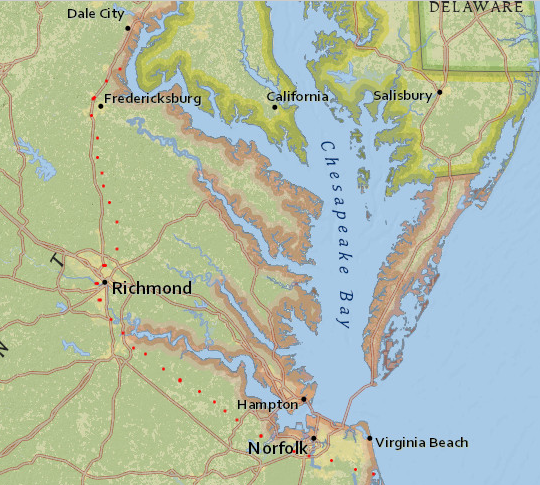
red dots outline a rough approximation of Tsenacommacah, the territory controlled by Powhatan in the early 1600's
Map Source: ESRI, ArcGIS Online
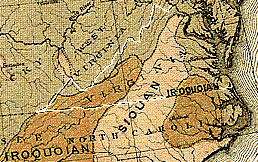 Powhatan's territory, Tsenacommacah, was limited to Algonquian-speaking groups. Powhatan ruled only between the Fall Line and the Atlantic Ocean, south to the Blackwater River and today's Virginia Beach and north to Potomac Creek and Aquia Creek. He also dominated those tribes on the Eastern Shore, which could be reached only by canoe until the Europeans brought the new technology of sailing ships.
Powhatan's territory, Tsenacommacah, was limited to Algonquian-speaking groups. Powhatan ruled only between the Fall Line and the Atlantic Ocean, south to the Blackwater River and today's Virginia Beach and north to Potomac Creek and Aquia Creek. He also dominated those tribes on the Eastern Shore, which could be reached only by canoe until the Europeans brought the new technology of sailing ships.
Tribes belonging to the Siouan and Iroquoian linguistic groups occupied the area between the Fall Line and the Blue Ridge. Most of the tribes west of the Fall Line, in the Virginia Piedmont and apparently in the Valley of Virginia west of the Blue Ridge, spoke languages belonging to the Siouan linguistic group.
Different Siouan-speaking groups in the Piedmont established separate claims to lands west of the Fall Line. John Lederer, who wrote a journal about his explorations in 1669-70, was able to speak at least some of the Siouan languages. He recognized the capacity of those Native Americans to understand legal concepts:4

language groups indicate Native American boundaries prior to colonization
Source: Virginia Foundation for the Humanities, Beyond Jamestown: Virginia Indians Today and Yesterday (p.15)
The Meherrin and the Nottoway tribes in southeastern Virginia, who lived along the rivers that still bear their name, spoke languages belonging to the Iroquoian linguistic group. The Meherrin and Nottoway were separated from the Iroquoian-speaking tribes to the north and the west, but were physically close to other Iroquoian-speaking tribes in North Carolina, especially the Tuscarora. The Cherokee in southwestern Virginia also spoke a distinct language that was most closely related to the Iroquois.
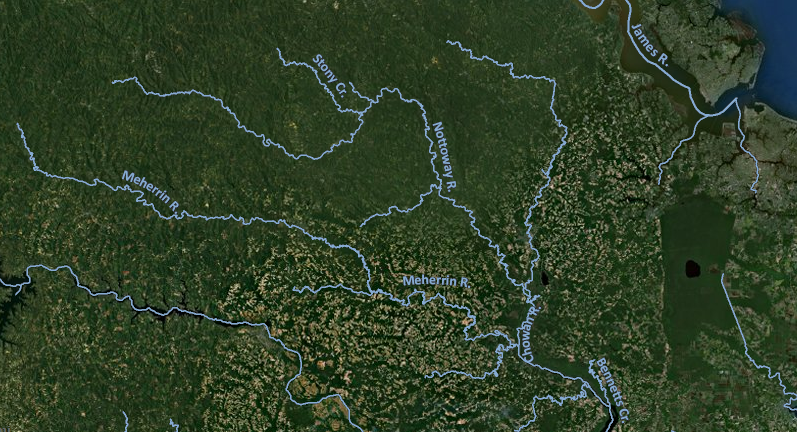
the Meherrin and Nottoway tribes lived in the Chowan River/Albemarle Sound watershed,
separate from the Chesapeake Bay watershed controlled by the paramount chiefdom of Powhatan
Source: ESRI, ArcGIS Online
Five Iroquoian-speaking tribes in New York, from the Mohawks on the east to the Seneca on the west, formed a powerful confederacy or "league." They deterred English colonists in Massachusetts from expanding west of the seacoast.
The Iroquoian-speaking Haudenosaunee threatened their Native American neighbors to the south. The northern tribes would send hunters on long expeditions down into the Virginia Piedmont and the Shenandoah Valley in the fall, where deer, turkeys, and other game were more plentiful than in the tribes' local area. The Siouan-speaking tribes in the Piedmont and Shenandoah Valley may have migrated away from those areas before European colonists arrived, in order to avoid conflict with the Iroquois.
The hunters on these Iroquois expeditions were not committed to peace with the Virginian colonists either, and the raids created alarm among the English settlers on the frontier. The military threat of Native American tribes to the western edge off Virginia (modern West Virginia) continued throughout the 1600's and 1700's, until the Treaty of Greenville was signed in 1795 after General "Mad Anthony" Wayne won the Battle of Fallen Timbers in Ohio.
The Indian land claims in Virginia were extinguished by a series of battles, treaties, and purchases. Twice, reservations were set aside for Native Americans in Virginia with white trustees responsible for court interactions involving land ownership issues and conflicts with adjacent neighbors, but later those reservations were dissolved officially so the lands could be sold to non-natives. The Accomac tribe lost its Gingaskin Reservation in Northampton County when termination began in 1812. The Nottoway reservation was terminated in 1824.5
Only two tribes in Virginia have managed to maintain continuous ownership of a portion of their ancestral lands for the last 400 years, as defined by English/American law. The Pamunkey and Mattaponi reservations in King William County are not the only lands in Virginia owned by tribal organizations now, but all other Native American "centers" involve lands that passed out of Native American ownership until being re-acquired recently.
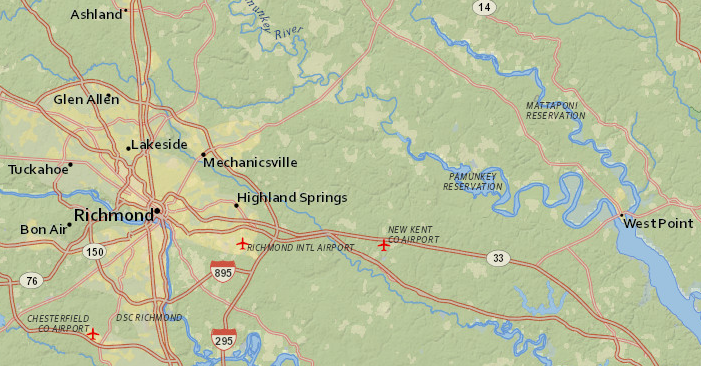
the Pamunkey Reservation was the only Native American land claim in Virginia that never disappeared over the last 400 years
(and the Mattaponi Reservation was later carved out of the Pamunkey territory)
Source: ESRI, ArcGIS Online
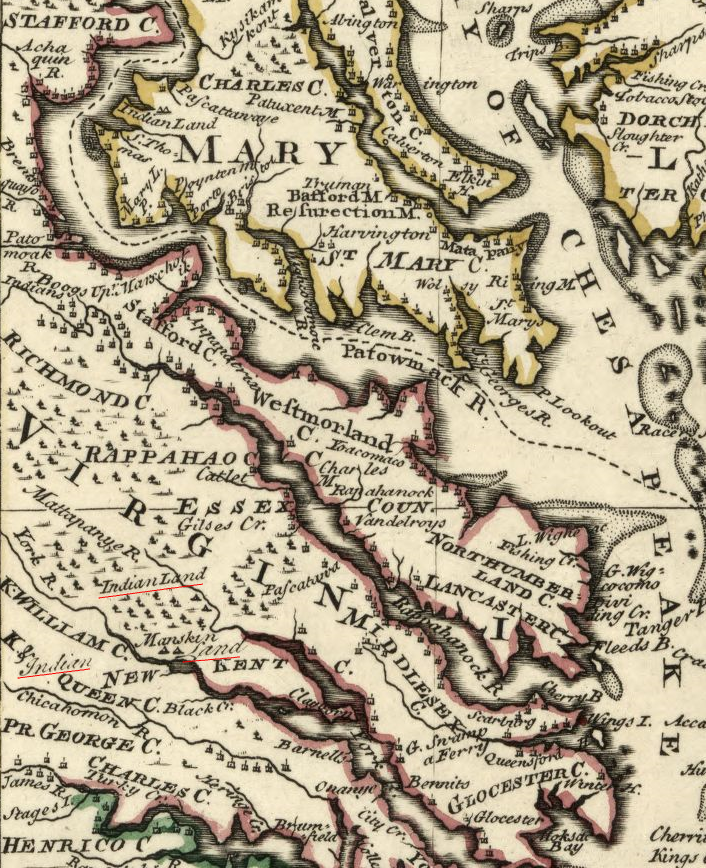
prior to the French and Indian War, territory north of the Chickahominy River was described as "Indian Land"
Source: Library of Congress, A new and accurate map of Virginia & Maryland (1752)